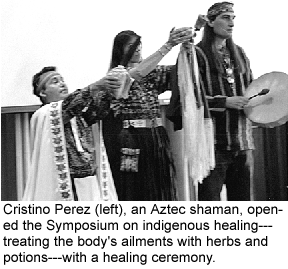The University Record, April 22,, 1997
Symposium explores experience of healing by ancient methods
By Deborah Gilbert
News and Information Services
 A conch horn wailed, a drum throbbed and cedar incense wafted through the Pendleton Room at the Michigan Union April 15 as Cristino B. Perez, an Aztec shaman, opened the symposium, “Indigenous Healing: Alive and Well,” by performing a healing ceremony that invoked the Great Spirit.
A conch horn wailed, a drum throbbed and cedar incense wafted through the Pendleton Room at the Michigan Union April 15 as Cristino B. Perez, an Aztec shaman, opened the symposium, “Indigenous Healing: Alive and Well,” by performing a healing ceremony that invoked the Great Spirit.
Cheryl M. Killion, assistant professor of nursing and symposium organizer, introduced Perez and his assistants, explaining that indigenous healing, which relies in part on belief, has an internal logic that is based on cultural and world views. It also is based on an enormous store of accumulated experience with healing plants and animals—wisdom that is being lost as indigenous cultures are Westernized and technologized. The symposium is a component of Killion’s course, “Cultural Aspects of Health and Illness.”
Perez said that indigenous tribes in North, South and Central America, who have been coming together recently to explore rituals and customs, are discovering that they share strikingly similar healing traditions, including dusting the ailing body with a feather or cedar boughs and laying on of hands to determine areas that need healing. Many tribes perform an annual sundance, purify themselves with steam and conduct “visionquests.”
“Physicians in Mexico,” he added, “are coming to accept the power of indigenous healing methods,” and are willing to use them in the healing process.
Mark J. Plotkin, an ethobotanist and executive director of the Ethnobiologist and Conservation Team in Washington, D.C., echoed Killion’s and Perez’s concern about lost indigenous knowledge and experience.
Author of Tales of a Shaman Apprentice, Plotkin has spent the past 15 years collecting healing plants in the Amazon. “I have a Harvard mentor,” he said, as a photograph of a distinguished, bearded scholar flashed on the screen, “and a shaman mentor,” he added, as an Amazonian shaman in a red breech cloth filled the screen. “Both,” he stressed, “are equally knowledgeable.”
Plotkin told the story of one shaman he knows who makes a potion of four plants that has a proven effect on diabetic patients. “The woman whom I saw had sores between her toes, an extremely high sugar count and was nearly comatose,” Plotkin said. “Twelve hours after administering the potion, her sugar count was normal. Her sores were healed within a week.”
Plotkin listed a staggering array of tropical plants and animals with medicinal uses, including fungi, frogs, leeches, insects and flowering plants that bloom 120 feet above the ground, sometimes just one fleeting week a year. “Every variety of leech secretes a different kind of anti-coagulant. The monkey frog secretes a compound that is very effective in treating high blood pressure. Cone snails secrete some 200 different peptide-poisons, including a promising new substitute for morphine,” he said.
May apple compounds shrink genital warts and rosy periwinkle helps childhood leukemia. The philodendron vine drips a pain killer, and some kinds of Amazonian ants are good for relief of rheumatism.
Indigenous tribes have been shamed, tragically, into abandoning their cultures by missionaries and other Westerners, according to Plotkin. To counter that trend, Plotkin has established the “Shamans’ Apprentice Program,” which utilizes a new training model for ethnobotanists so they can learn from shamans before their wisdom is lost to mankind.

